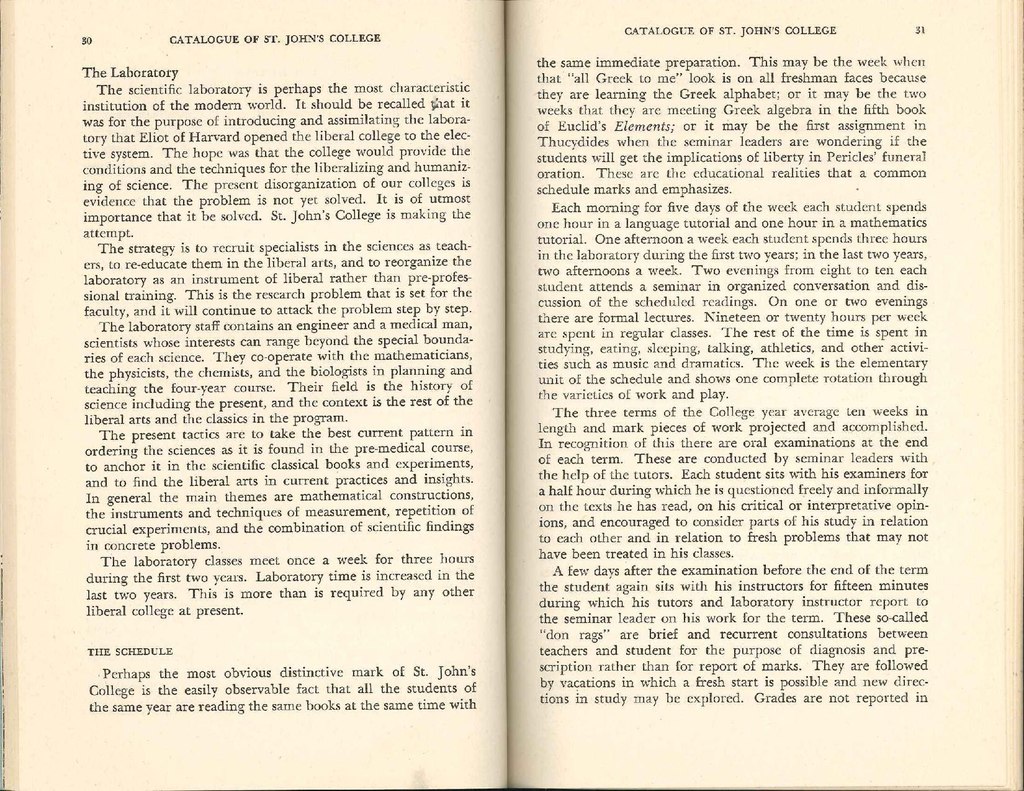The Laboratory
The scientific laboratory is perhaps the most characteristic institution of the modern world. It should be recalled that it was for the purpose of introducing and assimilating the laboratory that Eliot of Harvard opened the liberal college to the elective system. The hope was that the college would provide the conditions and the techniques for the liberalizing and humanizing of science. The present disorganization of our colleges is evidence that the problem is not yet solved. It is of utmost importance that it be solved. St. John's College is making the attempt.
The strategy is to recruit specialists in the sciences as teachers, to re-educate them in the liberal arts, and to reorganize the laboratory as an instrument of liberal rather than pre-professional training. This is the research problem that is set for the faculty, and it will continue to attack the problem step by step.
The laboratory staff contains an engineer and a medical man, scientists whose interests can range beyond the special boundaries of each science. They co-operate with the mathematicians, the physicists, the chemists, and the biologists in planning and teaching the four-year course. Their field is the history of science including the present, and the context is the rest of the liberal arts and the classics in the program.
The present tactics are to take the best current pattern in ordering the sciences as it is found in the pre-medical course, to anchor it in the scientific classical books and experiments, and to find the liberal arts in current practices and insights. In general the main themes are mathematical constructions, the instruments and techniques of measurement, repetition of crucial experiments, and the combination of scientific findings in concrete problems.
The laboratory classes meet once a week for three hours during the first two years. Laboratory time is increased in the last two years. This is more than is required by any other liberal college at present.
the schedule
Perhaps the most obvious distinctive mark of St. John's College is the easily observable fact that all the students of the same year are reading the same books at the same time with the same immediate preparation. This may be the week when that "all Greek to me" look is on all freshman faces because they are learning the Greek alphabet; or it may be the two weeks that they are meeting Greek algebra in the fifth book of Euclid's Elements; or it may be the first assignment in Thucydides when the seminar leaders are wondering if the students will get the implications of liberty in Pericles' funeral oration. These are the educational realities that a common schedule marks and emphasizes.
Each morning for five days of the week each student spends one hour in a language tutorial and one hour in a mathematics tutorial. One afternoon a week each student spends three hours in the laboratory during the first two years; in the last two years, two afternoons a week. Two evenings from eight to ten each student attends a seminar in organized conversation and discussion of the scheduled readings. On one or two evenings there are formal lectures. Nineteen or twenty hours per week are spent in regular classes. The rest of the time is spent in studying, eating, sleeping, talking, athletics, and other activities such as music and dramatics. The week is the elementary unit of the schedule and shows one complete rotation through the varieties of work and play.
The three terms of the College year average ten weeks in length and mark pieces of work projected and accomplished. In recognition of this there are oral examinations at the end of each term. These are conducted by seminar leaders with the help of the tutors. Each student sits with his examiners for a half hour during which he is questioned freely and informally on the texts he has read, on his critical or interpretative opinions, and encouraged to consider parts of his study in relation to each other and in relation to fresh problems that may not have been treated in his classes.
A few days after the examination before the end of the term the student again sits with his instructors for fifteen minutes during which his tutors and laboratory instructor report to the seminar leader on his work for the term. These so-called "don rags" are brief and recurrent consultations between teacher and student for the purpose of diagnosis and prescription rather than for report of marks. They are followed by vacations in which a fresh start is possible and new directions in study may be explored. Grades are not reported in
